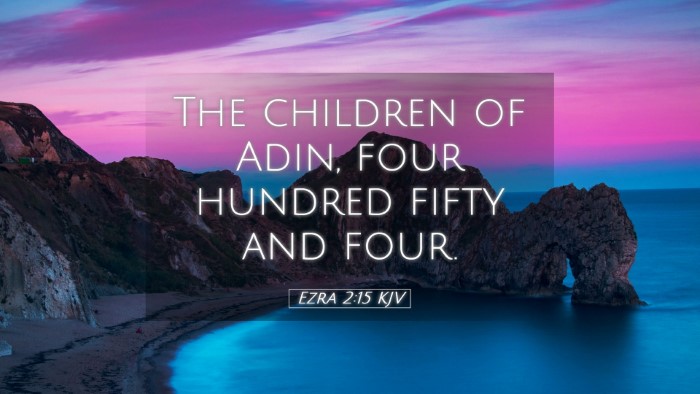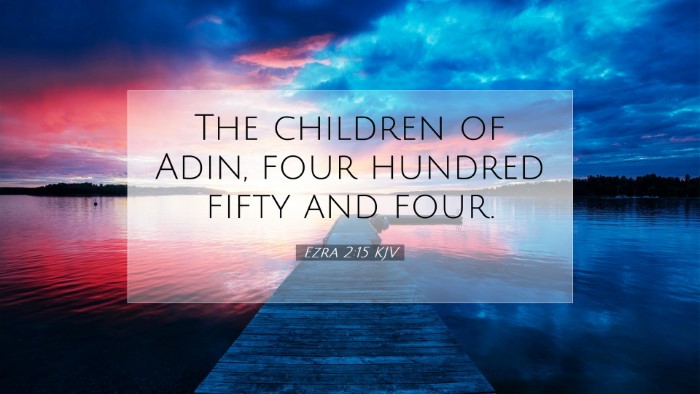Commentary on Ezra 2:15
Ezra 2:15 presents an important list of the families that returned from Babylonian exile to Jerusalem, including the mention of the children of Adin. This passage serves as a bridge between the pain of exile and the hope of restoration, reflecting not only the physical return but also the spiritual renewal of God's people.
Insights from Public Domain Commentaries
Matthew Henry's Commentary
Matthew Henry elaborates on the significance of Ezra 2:15 by noting the meticulous record-keeping of the returning exiles. Henry stresses the importance of names, not merely for historical purposes but as a testament to God's faithfulness in preserving a remnant of His people. In this verse, the mention of the children of Adin emphasizes God's unyielding commitment to His covenant people. Henry points out that the families returning symbolize hope, and their detailed record indicates that God knows His people intimately.
Albert Barnes' Notes
Albert Barnes provides an analytical approach to the list of families, emphasizing that the children of Adin numbered 454. Barnes highlights that the family of Adin reflects a significant subgroup among the exiles. The attention to the numerical count illustrates the restoration of community and the rekindling of the worship practices in Jerusalem. He notes that numbers in the biblical text often denote strength and divine order, suggesting that the return of these families is part of a larger plan orchestrated by God to reestablish proper worship in Jerusalem.
Adam Clarke’s Commentary
Adam Clarke's perspective centers on the historical context of the exiles. He remarks that the name "Adin" likely represents a specific family or clan that was significant during the Babylonian captivity. Clarke posits that this detailing signifies the reconstitution of Jewish identity and community, which is crucial for both the physical and spiritual rebuilding of Jerusalem. He encourages readers to draw parallels between returning exiles and the modern-day church, which often seeks to reclaim its identity after periods of struggle or separation.
Key Themes and Theological Reflections
- God's Faithfulness:
The return of the children of Adin is a striking testament to God's unwavering promise to restore His people. Throughout the Bible, God continually reaffirms His commitment to Israel, highlighting that no matter how far they stray, His plans remain intact.
- Identity and Community:
The meticulous listing of the returning families serves to re-establish the identity of the Jewish people. For pastors and scholars, it is crucial to note how identity formation is tied to land, heritage, and community, especially in the religious context.
- Restoration and Renewal:
This passage reflects a significant moment of restoration for Israel post-exile. The children's return signifies not just physical relocation but also a spiritual awakening and renewal, a theme that resonates through much of the prophetic literature and remains relevant today.
Conclusion
Ezra 2:15 encapsulates a profound moment in biblical history, demonstrating God's relentless pursuit of His people and the importance of community in the life of faith. As renowned theologians and commentators like Matthew Henry, Albert Barnes, and Adam Clarke illustrate, the details found in these verses serve as powerful reminders for modern believers about the necessity of remembering our roots, the collective identity we share, and the hope that drives us toward restoration in Christ.


